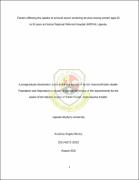| dc.contributor.author | Kusiima, Angela Merice | |
| dc.date.accessioned | 2024-04-02T09:03:31Z | |
| dc.date.available | 2024-04-02T09:03:31Z | |
| dc.date.issued | 2018-08-01 | |
| dc.identifier.uri | http://dissertations.umu.ac.ug/xmlui/handle/123456789/584 | |
| dc.description | Lillian Wampande | en_US |
| dc.description.abstract | Background: Cervical cancer is a public health concern that stretches from a local to global scale. This can be detected through early and regular cervical cancer screening. Cervical cancer screening was introduced in Hoima Regional Referral Hospital free of charge to all women of aged 21years and above. Despite this initiative by the government to decrease the mortality and morbidity rates resulting from cervical cancer, the uptake of cervical cancer has remained low among women in Hoima (DHIS statistic report, 2017).
Purpose: The study aimed at determining factors that affect the uptake of cervical cancer screening among women aged 25 to 65 years attending health services in Hoima regional Referral Hospital using the Health Belief Model.
Methods: A health facility based quantitative and qualitative cross sectional study design was used. The target population was women aged 25 to 65 years attending health services in Hoima Regional Referral Hospital during the study period. A total of 300 participants were selected using systematic sampling technique to assess their perceived susceptibility to cervical cancer, their perceived severity of cervical cancer, their perceived benefits of doing cervical cancer screening and their perceived barriers of seeking cervical cancer screening. Data was collected using a structured questionnaire. Data was analyzed using Statistical Package for Social Science (SPSS) Version 16.0 and findings presented using descriptive and inferential statistics with 0.05 as the significance threshold.
Results: Cervical cancer screening rate was 39%. Participants were aware of the perceived severity of cervical cancer (average response 2.58-3.60), perceived benefits of cervical cancer screening (average response 3.10-4.33) and perceived barriers to seeking cervical cancer screening (average response 2.0-3.44) but these were not significantly associated with screening. The highest predictor of cervical cancer screening was perceived susceptibility and those with high perceived susceptibility were 3.2 times more likely to do cervical cancer screening than those with low perceived susceptibility.
Conclusion: Even though participants were aware of cervical cancer existence, they had inadequate knowledge about cervical cancer screening services. Perceived susceptibility to cervical cancer was significantly associated with cervical cancer screening. Health education to both women and men towards increasing perceived susceptibility to cervical cancer can significantly improve the uptake of cervical cancer screening in Hoima as well as address issues of barriers and misconceptions associated with low uptake of cervical cancer screening. There is great need for the MOH to integrate cervical cancer screening services with other existing services in all health centers. | en_US |
| dc.language.iso | en | en_US |
| dc.publisher | Uganda Martyrs University | en_US |
| dc.subject | Cervical cancer screening | en_US |
| dc.subject | Women | en_US |
| dc.title | Factors affecting the uptake of cervical cancer screening services among women aged 25 to 65 years at Hoima Regional Referral Hospital (HRRH), Uganda. | en_US |
| dc.type | Dissertation | en_US |


